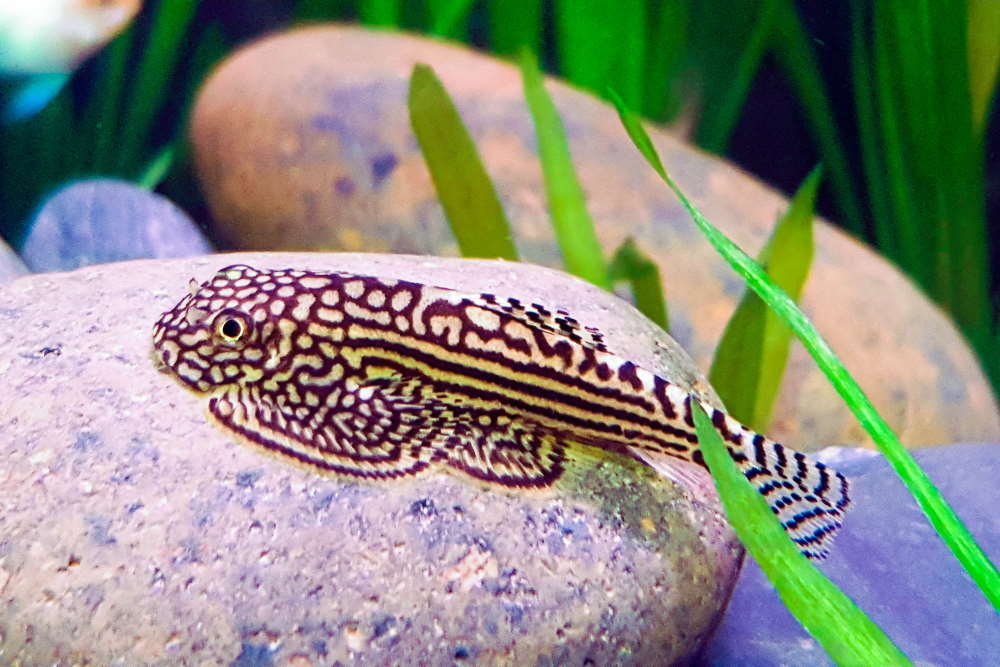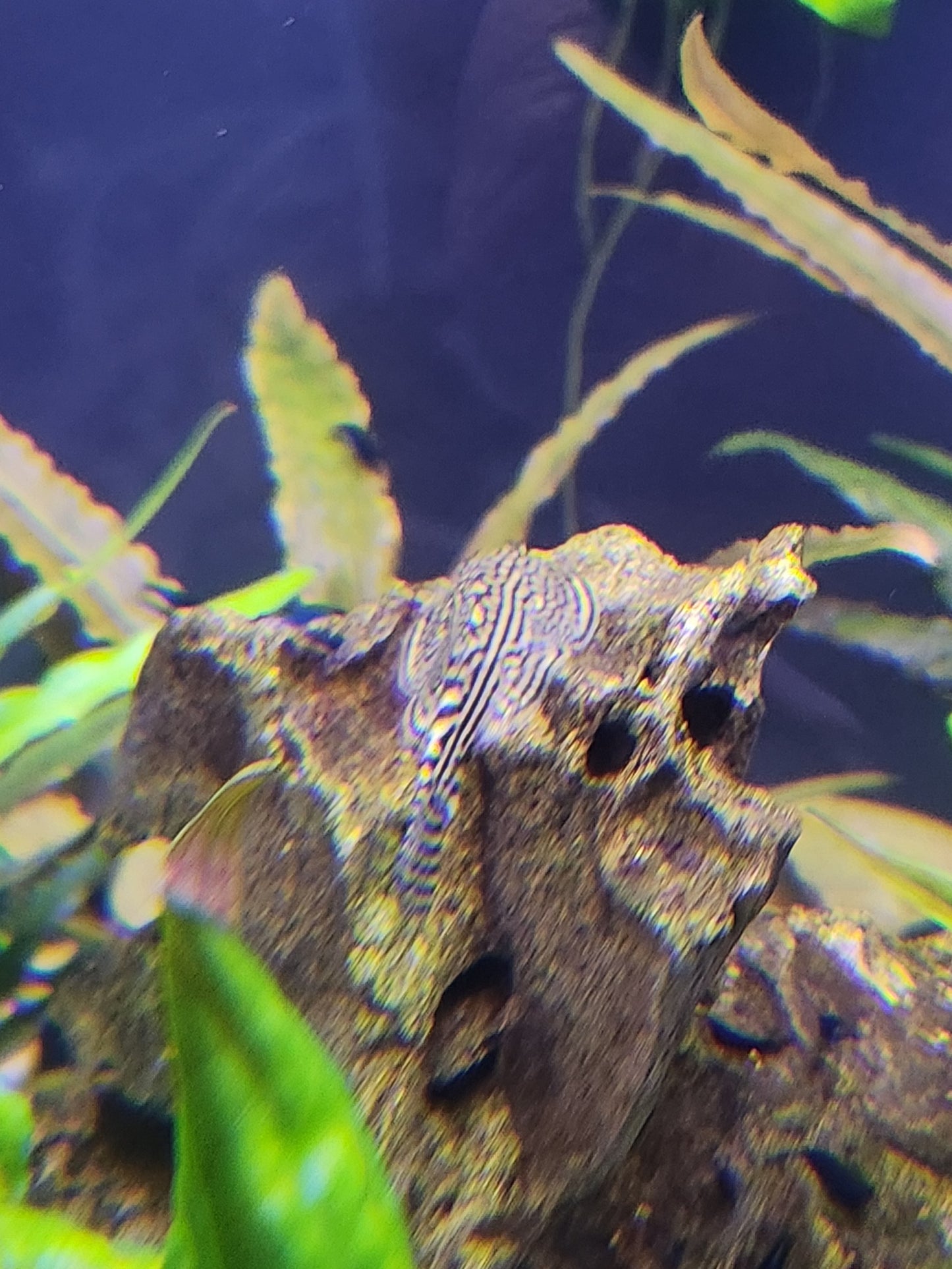Hill Stream Loach - Reticulated
Hill Stream Loach - Reticulated
12 in stock
Couldn't load pickup availability
To protect our animals and to ensure they get to our customers healthy and thriving, we will only ship our orders via UPS Next Day Air.
The Reticulated Hill Stream Loach (Beaufortia kweichowensis) is a fascinating species of freshwater fish that is known for its unique appearance and specialized care requirements. They are commonly referred to as "Hill Stream Loaches" due to their preference for fast-moving, oxygen-rich water. The Reticulated Hill Stream Loach, specifically, is recognized for its reticulated pattern (a net-like or mesh appearance on its body), which gives it a striking look. These loaches are native to the rivers and streams of Asia, particularly China, and are popular among aquarists who are interested in creating biotopes that mimic fast-flowing streams.
Here's everything you need to know about the Reticulated Hill Stream Loach:
1. Appearance:
-
Color: The Reticulated Hill Stream Loach has a unique and striking reticulated or net-like pattern on its body, which gives it its name. The body is typically a combination of light to dark brown, gray, or olive shades, with intricate dark lines that form a mesh-like pattern.
-
Shape: It has a flattened, streamlined body, which helps it cling to rocks in fast-moving water. The pectoral fins are large and paddle-like, aiding in this "clinging" behavior.
-
Size: These loaches are relatively small, growing to about 2-3 inches (5-8 cm) in length when fully grown.
2. Tank Requirements:
-
Tank Size: A minimum of a 20-gallon tank is recommended for a small group of Reticulated Hill Stream Loaches. However, larger tanks (30 gallons or more) are better, as they need plenty of space to explore and thrive.
-
Water Conditions:
-
Temperature: They prefer cooler water, typically between 68°F to 75°F (20°C to 24°C).
-
pH: Slightly acidic to neutral water is best, with a pH range of 6.5 to 7.5.
-
Water Hardness: Soft to medium hardness is ideal.
-
Oxygenation: High oxygenation is crucial. These loaches come from fast-flowing streams where the water is highly oxygenated. A good filtration system that ensures water movement is essential to replicate their natural environment.
-
-
Water Flow: Hill Stream Loaches need strong water movement, so a tank with a good filtration system that creates current is key. Powerheads, strong filters, or air stones can help achieve this.
3. Diet:
-
Omnivorous Diet: Reticulated Hill Stream Loaches are omnivores and will eat a variety of foods, including algae, biofilm, and small invertebrates they find in their natural environment.
-
Aquarium Foods: In the aquarium, they can be fed a variety of foods like algae wafers, blanched vegetables (e.g., zucchini, spinach), shrimp pellets, and daphnia. They will also graze on algae and biofilm naturally growing on rocks, glass, and substrate.
-
Feeding Frequency: They can be fed once or twice a day, but it's important to ensure they have access to algae and biofilm in between feedings, as they spend a lot of time foraging.
4. Behavior:
-
Peaceful: These loaches are generally peaceful and non-aggressive. They are great additions to peaceful community tanks, especially with other species that enjoy similar water conditions.
-
Active and Social: Reticulated Hill Stream Loaches are active fish, constantly foraging on surfaces in the tank. They are also very social and should be kept in groups of 3 or more to feel secure and exhibit natural behavior.
-
Bottom-Dwelling: They are bottom dwellers, spending most of their time clinging to rocks or swimming along the substrate. They often position themselves in areas with the strongest current.
5. Tankmates:
-
Peaceful Tankmates: Reticulated Hill Stream Loaches get along with other peaceful species that enjoy similar water conditions, such as small tetras, rasboras, and other loaches.
-
Avoid Aggressive Fish: Avoid keeping them with aggressive fish or large species that may stress them out or outcompete them for food.
-
Other Loaches: They can live peacefully with other species of loaches that thrive in similar conditions, such as Siamese algae eaters or other hill stream loaches.
6. Breeding:
-
Breeding Reticulated Hill Stream Loaches in captivity is difficult. These loaches require very specific conditions for spawning, including strong water currents and certain temperature ranges.
-
There isn’t much information available about breeding in home aquariums, and in many cases, these loaches are not commonly bred in captivity.
-
Eggs and Fry: Like many loaches, they lay eggs, but raising the fry requires stable water conditions and high-quality food.
7. Maintenance and Care:
-
Water Changes: Due to their sensitivity to poor water conditions, it's important to perform regular water changes (about 20-30% per week) to maintain water quality.
-
Tank Setup: The tank should be designed to replicate the loaches' natural environment, with plenty of rocks, driftwood, and live plants (though keep in mind the current will likely dislodge fragile plants).
-
Substrate: A fine-gravel or smooth substrate works well, as it simulates the rocky beds of fast-moving streams.
-
Algae Growth: Provide surfaces like rocks and aquarium glass for algae growth, as they will graze on this naturally.
8. Lifespan:
-
With proper care, Reticulated Hill Stream Loaches can live up to 5-7 years or more in the right conditions.
Fish may not be identical to the pictures you see online when receiving. Most are photos of the parents and to show what they will grow up like to resemble.



